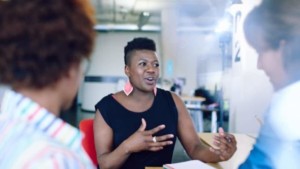A Gifted Ed Teacher’s Secrets to Success

By Stephen Noonoo
Today’s colleges of education generally do a good job prepping new teachers for the traditional classroom. For teaching students outside the mainstream, the training is less robust. At least, that’s what Alison Alowonle discovered when she stepped into her first student-teaching job in a gifted ed magnet school 13 years ago and fell in love with the students.
When she moved to a classroom of her own, she started small, clustering increasing numbers of gifted students each year before designing her own pullout program at Excelsior Elementary in Minnetonka, Minnesota, picking up a certificate in gifted education along the way. This year she was one of 11 finalists for her state’s 2017 Teacher of the Year award.
“Gifted” is a label that’s often difficult to quantify, but there’s little doubt Alowonle’s elementary students are exceptional. To qualify for her class, students must demonstrate an IQ upward of 140 and pass through a simulation designed to test their intellect. But intelligence alone is not what makes them unique. According to Alowonle, her students also exhibit high levels of inward motivation and drive; “intensity” is one of her favorite words to describe it.
Here, Alowonle shares her recommendations for engaging gifted students.
Q: How does your “looping” model of teaching work?
I teach students for two years in a row. My homeroom is fourth- and fifth-graders: 21 students, a mix of boys and girls who are together two years. It’s nice because the fifth-graders are really the mentors, and then the next year the fourth-graders loop around and get to take on that role. It’s a really great chance for them to grow in leadership. What’s nice about that looping piece is that you can hit the ground running. You know half your students already at the start of the year. They know the rules and they can help teach the new kids. You don’t have to spend a lot of time in that “getting to know you” phase. We get a lot more instructional time that way, too.
There are kids here who have been ostracized or isolated as gifted children, and they come here and suddenly they’re with like-minded peers. They feel comfortable to talk about things they’re interested in, and not be met with confusion or be laughed at. They feel like they can be themselves.
They are very diverse in their interests and personalities. There are a lot of athletic kids and others who don’t even go near athletics. The one common area they have is their intensity. A psychomotor intensity, rapid speech, creative intensity, imaginational. They’re all very intense in their own way, and then they’re brought together in that commonality.
We do a lot around the whole child, the social-emotional learning. For instance, during the first few weeks of school, we talk about executive functioning. We look at the brain and why we react the way we do emotionally, and how we can calm ourselves when we’re in a state of fight-or-flight. My students are unique in their intensities and emotions.
Q: Are there any other ways you’d say your students are in any ways different from those in a traditional classroom?
They are similar in many ways. Just like most classrooms, I have kids who are calm and can sit all day and don’t need to say “look at me,” and then there are others who can’t stop moving or talking.
However, the child in my class who is quiet is usually very intense on the inside. They go deep in their thinking and are quick-processing for the most part. Instead of needing five examples of something before moving to the application phase, they might need only two examples, or even just one. The pacing between this and a regular class is very different. It’s very speedy. There’s not a lot of “sit and get.”
Q: Taking all that into consideration, how do you typically organize lessons?
It’s a lot of project-based learning here. For instance, in chemistry we’ll work on learning the properties of atoms and bonds and we’ll go through the whole chemistry unit, but then it’s peppered throughout with different labs they can do. At the end of a unit, they complete an individual project where they can ask themselves, “What do I want to do with this?” They can do some experimenting at home, or in the classroom. The only criteria I have is to incorporate something from the unit and then go deep with it.
Q: How do you grade and assess students of this caliber? Are they naturally competitive?
Yes, they are competitive. They all like to do well and they’re close-knit. It’s very much like a family. There’s a lot of encouraging, but also some competition. We use Marzano’s rubric, a 0-4 scale, which is really great for kids in general but especially for gifted kids.
If you get a three, we’re saying, “You got it. You picked up what I was throwing down.” Anything above that is where you have a chance to go above and beyond and do something I haven’t taught you with it. Maybe one of the literature assignments I’ll give is to take the protagonist and tell three of their character traits and find evidence in the story as to why these character traits are true to this character. If they pick their three traits and they give evidence, you get the three. But if a child goes through and doesn’t just cite pages but uses direct quotes, and I haven’t taught that it would get them a 3.5 or a 4. It allows them the opportunity to reach and figure out what can they can do above and beyond.
Q: You spend a lot of your time working not only with kids but with their families as well. What does that entail?
The family is super important. That’s a huge component for me. I think the most important thing is to almost over-communicate things. I send out a very detailed weekly newsletter about what it looks like to be a child in this room for a week. I write down what we’ve been doing each day, in each subject, each project. Especially because a lot of students struggle with executive functioning, planning and meeting deadlines. I lay it out for the parents: Here’s what you might want to be asking the child. Here’s something you can do at home to extend the learning going on the classroom. It’s very helpful.
I’ll also send periodic emails to check in with parents to let them know how things are going. I always try to touch on the positives, which is something they’re not always used to. I’ve had responses from parents saying: “I’m really surprised by your email. I thought this was going to be another email about how my child was sent home today,” because their child has had difficulties in the past. I’m not talking about all the students in my class, but there are definitely those who have been a round peg in a square hole, and school has been hard for them. As a parent, conferences aren’t going to be the most fun to go to. Your child is constantly off task, or reading a book instead of paying attention.
I think, as a parent, ‘What would I want to know?’ I would like to know some anecdotal information about how my son is doing. If you put yourself in those parents’ shoes and ask, “What kind of relationship would I want with that teacher?” That’s what I try to put forth.
Q: Do you have any advice for teachers looking to learn more about gifted ed or move into that space?
I think it’s important to get some sort of education yourself. I have my gifted education certificate. Those classes were really helpful for me. The training you get in college is really skimpy. Gifted ed is actually grouped in with special ed. I’ve even gotten out my old college textbook and there’s one paragraph in there on gifted kids. Things have changed now, though: you can get your master’s in gifted ed and there are staff development opportunities.
But you also need to get hands-on experience. If you’re a regular third-grade teacher and you have a gifted program in your school, get to know that gifted ed teacher. Pop in during your prep or lunch time and see what’s going on. It’s a great opportunity to get to know these unique individuals.
For more, see:
- Should I Grade-Skip My Gifted Child?
- 7 Ways to Build Better Relationships with Students
- Professional Grade: Magic Happens When Students Own High Standards
Stephen Noonoo is a freelance writer, editor and ed tech consultant. Follow him on Twitter: @stephenoonoo
Stay in-the-know with all things EdTech and innovations in learning by signing up to receive the weekly Smart Update.





0 Comments
Leave a Comment
Your email address will not be published. All fields are required.